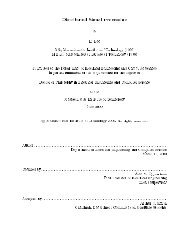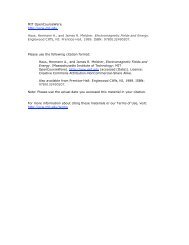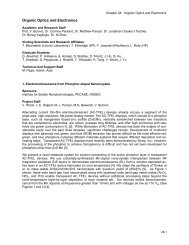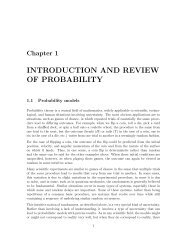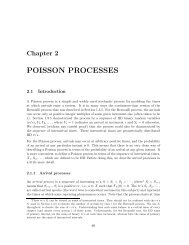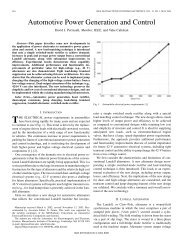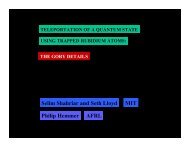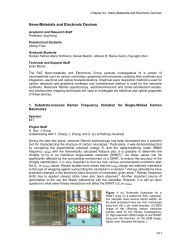Physics of Single Electron Transistors and Doped Mott Insulators
Physics of Single Electron Transistors and Doped Mott Insulators
Physics of Single Electron Transistors and Doped Mott Insulators
Create successful ePaper yourself
Turn your PDF publications into a flip-book with our unique Google optimized e-Paper software.
<strong>Physics</strong> <strong>of</strong> <strong>Single</strong> <strong>Electron</strong> <strong>Transistors</strong> <strong>and</strong> <strong>Doped</strong> <strong>Mott</strong> <strong>Insulators</strong><br />
Keywords: <strong>Single</strong> electron devices, High Temperature Superconductivity<br />
Academic <strong>and</strong> Research Staff: M. A. Kastner, Department <strong>of</strong> <strong>Physics</strong><br />
Research Staff:<br />
David Goldhaber-Gordon, Postdoctoral Research Associate, Department <strong>of</strong> <strong>Physics</strong><br />
Yuri Khavin, Postdoctoral Fellow, Department <strong>of</strong> <strong>Physics</strong><br />
Graduate Students:<br />
Nicole Morgan, Research Assistant, Department <strong>of</strong> <strong>Physics</strong><br />
K. Jessica Thomas, Research Assistant, Department <strong>of</strong> <strong>Physics</strong><br />
Ian Zacharia, Research Assistant, Department <strong>of</strong> <strong>Physics</strong><br />
Ila Prasad, Research Assistant, Department <strong>of</strong> <strong>Physics</strong>, Harvard University<br />
Statistics <strong>of</strong> the Coulomb-blockade peak spacings <strong>of</strong> a silicon quantum dot<br />
Sponsor: ARO 66506, 66649<br />
Personnel: Simmel F, Abusch-Magder D, Wharam DA, Kastner MA, Kotthaus JP<br />
We have made a study <strong>of</strong> the fluctuations <strong>of</strong> Coulomb-blockade peak positions <strong>of</strong> a quantum dot.<br />
The dot is defined by patterning the two-dimensional electron gas <strong>of</strong> a silicon metal-oxidesemiconductor<br />
field-effect transistor structure using stacked gates. This permits variation <strong>of</strong> the<br />
number <strong>of</strong> electrons on the quantum dot without significant shape distortion. The ratio <strong>of</strong> charging<br />
energy to single-particle energy is considerably larger than in comparable GaAs/Al x Ga 1-x As<br />
quantum dots. The statistical distribution <strong>of</strong> the conductance peak spacings in the Coulombblockade<br />
regime was found to be unimodal <strong>and</strong> does not follow the Wigner surmise. The<br />
fluctuations <strong>of</strong> the spacings are much larger than the typical single-particle level spacing <strong>and</strong> thus<br />
clearly contradict the expectation <strong>of</strong> constant interaction-r<strong>and</strong>om matrix theory.<br />
Kondo effect in a single-electron transistor<br />
Sponsor: ARO 66506, 66649<br />
Personnel: D. Goldhaber-Gordon, H. Shtrikman, D. Mahalu, D. Abusch-Magder, U. Meirav, M. A.<br />
Kastner<br />
We demonstrate that the conductance through a single-electron transistor at low temperature is in<br />
quantitative agreement with predictions <strong>of</strong> the equilibrium Anderson model. The Kondo effect is<br />
observed when an unpaired electron is localized within the transistor. Tuning the unpaired<br />
electron's energy toward the Fermi level in nearby leads produces a crossover between the<br />
Kondo <strong>and</strong> mixed-valence regimes <strong>of</strong> the Anderson model.<br />
Quantum Magnetism<br />
Sponsor: NSF/MRSEC 62252 DMR 98-08941<br />
Personnel: F. C. Chou, A. Aharony, R. J. Birgeneau, O. Entin-Wohlman, M. Greven, A. B. Harris,<br />
M. A. Kastner, Y. J. Kim, Y. S. Lee Endoh Y, Shirane G, Yamada K, Erwin RW, Greven M.,<br />
Parks, ME, Q.Zhu, B.O. Wells
The transition-metal oxide IRG <strong>of</strong> the MRSEC at MIT has the goal <strong>of</strong> underst<strong>and</strong>ing the interplay<br />
<strong>of</strong> magnetism <strong>and</strong> electron motion in materials related to those which display high temperature<br />
superconductivity. The group focuses on Cu oxides, which contain spin-1/2 ions in unusual<br />
geometries. In particular, the high temperature superconductors all have CuO 2 layers in which<br />
the spin-1/2 ions are arranged on a square lattice <strong>and</strong> the nearest neighbors interact in a way that<br />
is well-dexcribed by the Heisenberg model: JSi•Sj. These are quantum magnets because the<br />
small spin results in large quantum mechanical fluctuations in magnetic moment. Other quantum<br />
magnets that have received attention recently are those containing chains <strong>of</strong> Cu ions or pairs <strong>of</strong><br />
chains (ladders) weakly coupled to each other.<br />
The Cu 3 O 4 layer in Sr 2 Cu 3 O 4 Cl 2 is a variant <strong>of</strong> the square CuO 2 lattice <strong>of</strong> the high-temperature<br />
superconductors, in which the center <strong>of</strong> every second plaquette contains an extra Cu 2+ ion. The<br />
ions that make up the conventional CuO 2 network, called CuI, have CuI-CuI exchange energy<br />
~130 meV, <strong>and</strong> order antiferromagnetically at about 380 K; the Cull-Cull exchange is only ~ 10<br />
meV, <strong>and</strong> the Cull's order at ~ 40 K. We have studied the dependence <strong>of</strong> the magnetization on<br />
field, temperature, <strong>and</strong> crystallographic orientation for this interesting system. We show that the<br />
small permanent ferromagnetic moment, that appears when the CuI spins order, <strong>and</strong> the unusual<br />
spin rotation transitions seen most clearly for one particular direction <strong>of</strong> the magnetic field, are the<br />
result <strong>of</strong> several small bond-dependent anisotropic terms in the spin Hamiltonian that are<br />
revealed because <strong>of</strong> the frustration <strong>of</strong> the isotropic Heisenberg interaction between CuI <strong>and</strong> Cull<br />
spins. These include a term which favors collinearity <strong>of</strong> the CuI <strong>and</strong> CuII spins, which originates<br />
from quantum fluctuations, <strong>and</strong> also a pseudodipolar interaction. Some <strong>of</strong> these small interactions<br />
also come into play in other lamellar cuprates, connected with the high-T c superconductivity<br />
materials, <strong>and</strong> in many spin-chain <strong>and</strong> spin-ladder compounds.<br />
The classical ground state <strong>of</strong> this system is degenerate, due to frustration <strong>of</strong> the intersubsystem<br />
interactions. Magnetic neutron scattering experiments show that quantum fluctuations cause a<br />
two dimensional Ising ordering <strong>of</strong> the Cu-II's, lifting the degeneracy, <strong>and</strong> a dramatic increase <strong>of</strong><br />
the Cu-I out-<strong>of</strong>-plane spin-wave gap, unique for order out <strong>of</strong> disorder. The spin-wave energies are<br />
quantitatively predicted by calculations which include quantum fluctuations.<br />
We have carried out a quantum Monte Carlo study <strong>of</strong> the thermodynamic properties <strong>of</strong> arrays <strong>of</strong><br />
spin ladders with various widths (n), coupled via a weak interladder exchange coupling αJ, where<br />
J is the intraladder coupling both along <strong>and</strong> between the chains. This coupled ladder system<br />
serves as a simplified model for the magnetism <strong>of</strong> presumed ordered spin <strong>and</strong> charge stripes in<br />
the two-dimensional CuO 2 planes <strong>of</strong> hole-doped copper oxides. Our results for n = 3 with weak<br />
interladder coupling α = 0.05, estimated from the t-t'-t"-J model, show good agreement with the<br />
ordering temperature <strong>of</strong> the recently observed spin-density-wave condensation in La 2 CuO 4+y . We<br />
show that there exists a quantum critical point at α c ~ 0.07 for n = 4, <strong>and</strong> determine the phase<br />
diagram. Our data at this quantum critical point agree quantitatively with the universal scaling<br />
predicted by the quantum nonlinear a model. We also report results on r<strong>and</strong>om mixtures <strong>of</strong> n = 2<br />
<strong>and</strong> n = 3 ladders, which correspond to the doping region near but above 1/8. Our study <strong>of</strong> the<br />
magnetic static structure factor reveals a saturation <strong>of</strong> the incommensurability <strong>of</strong> the spin<br />
correlations around 1/8, while the incommensurability <strong>of</strong> the charge stripes grows linearly with<br />
hole concentration.<br />
We have carried out a neutron-scattering study <strong>of</strong> the instantaneous spin-spin correlations in<br />
La 2 CuO 4 (T N = 325 K) over the temperature range 337-824 K. Incident neutron energies varying<br />
from 14.7-115 meV have been employed in order to guarantee that the energy integration is<br />
carried out properly. The results so obtained for the spin-correlation length as a function <strong>of</strong><br />
temperature when expressed in reduced units agree quantitatively both with previous results for<br />
the two-dimensional (2D) tetragonal material Sr 2 CuO 2 Cl 2 , <strong>and</strong> with quantum Monte Carlo results<br />
for the nearest-neighbor square lattice S = 1/2 Heisenberg model. All <strong>of</strong> the experimental <strong>and</strong><br />
numerical results for the correlation length are well described without any adjustable parameters<br />
by the behavior predicted for the quantum nonlinear sigma model in the low-temperature
enormalized classical regime. The amplitude, on the other h<strong>and</strong>, deviates subtly from the<br />
predicted low-temperature behavior.<br />
Neutron-scattering study <strong>of</strong> spin-density wave order in the superconducting state <strong>of</strong><br />
excess-oxygen-doped La 2 CuO 4+y<br />
Sponsor: NSF/MRSEC 62252 DMR 98-08941<br />
Personnel: Lee YS, Birgeneau RJ, Kastner MA, Endoh Y, Wakimoto S, Yamada K, Erwin RW,<br />
Lee SH, Shirane G<br />
We have made neutron-scattering measurements <strong>of</strong> spin-density wave order within the<br />
superconducting state <strong>of</strong> a single crystal <strong>of</strong> predominately stage-4 La 2 CuO 4+y with a T c (onset) <strong>of</strong><br />
42 K. The low-temperature elastic magnetic scattering is incommensurate with the lattice <strong>and</strong> is<br />
characterized by long-range order in the copper-oxide plane with the spin direction identical to<br />
that in the insulator. Between neighboring planes, the spins exhibit short-range correlations with a<br />
stacking arrangement reminiscent <strong>of</strong> that in the undoped antiferromagnetic insulator. The elastic<br />
magnetic peak intensity appears at the same temperature within the errors as the<br />
superconductivity, suggesting that the two phenomena are strongly correlated. These<br />
observations directly reveal the persistent influence <strong>of</strong> the antiferromagnetic order as the doping<br />
level increases from the insulator to the superconductor. In addition, our results confirm that spindensity<br />
wave order for incommensurabilities near 1/8 is a robust feature <strong>of</strong> the La 2 CuO 4- based<br />
superconductors.<br />
Observation <strong>of</strong> incommensurate magnetic correlations at the lower critical concentration<br />
for superconductivity in La 2-x Sr x CuO 4 (x=0.05)<br />
Sponsor: NSF/MRSEC 62252 DMR 98-08941<br />
Personnel: Wakimoto S, Shirane G, Endoh Y, Hirota K, Ueki S, Yamada K, Birgeneau RJ,<br />
Kastner MA, Lee YS, Gehring PM, Lee SH<br />
Neutron-scattering experiments have been performed on lightly doped La 2-x Sr x CuO 4 single<br />
crystals in both the insulating (x = 0.03,0.04,0.05) <strong>and</strong> superconducting (x = 0.06) regions. Elastic<br />
magnetic peaks are observed at low temperatures in all samples with the maximum peak<br />
linewidth occurring at the critical concentration x = 0.05. Incommensurate peaks are observed<br />
only at x = 0.05, the positions <strong>of</strong> which are rotated by 45 degrees in reciprocal space about (π,π)<br />
from those observed for x ≥ 0.06 in the superconducting phase.<br />
Neutron-scattering study <strong>of</strong> static antiferromagnetic correlations in La 2-x Sr x Cu 1-y Zn y O 4<br />
Personnel: Kimura H, Hirota K, Matsushita H, Yamada K, Endoh Y, Lee SH, Majkrzak CF, Erwin<br />
R, Shirane G, Greven M, Lee, YS, Kastner MA, Birgeneau RJ<br />
Neutron-scattering measurements have been performed to search for possible elastic<br />
incommensurate magnetic peaks in superconducting La 2-x Sr x CuO 4 with x=0.10, 0.12, <strong>and</strong> 0.15.<br />
The most dramatic effects are found for x=0.12; in this case, the peak intensity first appears at<br />
the onset <strong>of</strong> superconductivity Tc (=31 K). The resolution-limited peak width indicates that the<br />
static magnetic correlation length exceeds 200 Angstrom isotropically in the CuO 2 planes. Weak<br />
elastic peaks are also observed at low temperatures for x=0.10 while for x = 0.15 any<br />
incommensurate elastic scattering is below the limit <strong>of</strong> detectability. Elastic peaks are observed in<br />
Zn-substituted nonsuperconducting La 1.88 Sr 0.12 Cu 0.97 Zn 0.03 O 4 However, in this case, the Zn<br />
substitution degrades the magnetic order; the peak appears at lower temperature (17 K) <strong>and</strong> the<br />
correlation length is shorter (80 Angstrom) than that in the Zn-free x = 0.12 sample.
Publications<br />
Kastner, M.A., A. Aharony, R.J. Birgeneau, F.C. Chou, O. Entin-Wohlman, M. Greven, A. B.<br />
Harris, Y. J. Kim, Y. S. Lee, M. E. Parks, <strong>and</strong> Q. Zhu, “Field Dependent Antiferromagnetism <strong>and</strong><br />
Ferromagnetism <strong>of</strong> the Two Copper Sublattices in Sr 2 Cu 3 O 4 Cl 2, ” Phys. Rev. B 59, 14702 (1999).<br />
Birgeneau R.J., M.A. Kastner, Y.S.Lee, B.O. Wells, Y. Endoh, K. Yamadan <strong>and</strong> G. Shirane,<br />
“Instantaneous Spin Correlations in La 2 CuO 4 ”, Phys. Rev. B. 59, 13788 (1999).<br />
Kiryukhin V., Y.J. W<strong>and</strong>, F.C. Chou, M. A. Kastner, <strong>and</strong> R. J. Birgeneau, “X-ray-induced structural<br />
transition in La 0.875 Sr 0.125 MnO 3 ”, Phys. Rev. B 59, R6581 (1999).<br />
Kim Y.J., A. Aharony, R. J. Birgeneau, F. C.Chou, O. Entin-Wohlman, R.W.Erwin, M. Greven,<br />
A.B. Harris, M.A. Kastner, I.Ya. Korenblit, Y.S. Lee, <strong>and</strong> G. Shirane, “Ordering due to Quantum<br />
Fluctuations in Sr 2 Cu 3 O 4 Cl 2 ”, Phys. Rev. Letters 83, 852 (1999).<br />
Simmel F., D. Abusch-Magder, D.A. Wharam, M. A. Kastner, <strong>and</strong> J.P. Kotthaus, “Statistics <strong>of</strong> the<br />
Coulomb blockade peak spacings <strong>of</strong> a Si quantum dot”, Phys. Rev. B 59, R10441 (1999).<br />
Kimura H., K. Hirota, H. Matsushita, K. Yamada, S.-H. Lee, C. F. Majkrzak, R. Erwin, G. Shirane,<br />
M. Greven, Y. S. Lee, M. A. Kastner, <strong>and</strong> R. J. Birgeneau, “Neutron-scattering study <strong>of</strong> static<br />
antiferromagnetic correlations in La 2 – x Sr x Cu 1 – y Zn y O 4 ”, Phys. Rev. B 59, 6517 (1999).<br />
Wakimoto S., G. Shirane, Y. Endoh, K. Hirota, S. Ueki, K. Yamada, R. J. Birgeneau, M. A.<br />
Kastner, Y. S. Lee, P. M. Gehring <strong>and</strong> S. H. Lee, “Observation <strong>of</strong> incommensurate magnetic<br />
correlations at the lower critical concentration for superconductivity in La 2–x Sr x CuO 4 (x = 0.05)”,<br />
Phys. Rev. B 60, R769 (1999).<br />
Kim Y. J., R. J. Birgeneau, M. A. Kastner, Y. S. Lee, Y. Endoh, G. Shirane, <strong>and</strong> K. Yamada,<br />
“Quantum Monte Carlo study <strong>of</strong> weakly coupled spin ladders”, Phys. Rev. B 60, 3294 (1999).<br />
Lee Y. S., R. J. Birgeneau, M. A. Kastner, Y. Endoh, S. Wakimoto, K. Yamada, R. W. Erwin, S.-<br />
H. Lee, <strong>and</strong> G. Shirane, “Neutron-scattering study <strong>of</strong> spin-density wave order in the<br />
superconducting state <strong>of</strong> excess-oxygen-doped La 2 CuO 4 + y ”, Phys. Rev. B 60, 3643 (1999).<br />
Kimura H., H. Matsushita, K. Hirota, Y. Endoh, K. Yamada, Y. S. Lee, M. A. Kastner, <strong>and</strong> R. J.<br />
Birgeneau, “Neutron scattering study <strong>of</strong> incommensurate elastic magnetic peaks in<br />
La 1.88 Sr 0.12 CuO 4 ”, Journal <strong>of</strong> <strong>Physics</strong> <strong>and</strong> Chemistry <strong>of</strong> Solids, 60, 1067 (1999).<br />
Wakimoto S., K. Yamada, S. Ueki, G. Shirane, Y. S. Lee, M. A. Kastner, K. Hirota, P. M.<br />
Gehring, Y. Endoh, <strong>and</strong> R. J. Birgeneau, “Neutron scattering study <strong>of</strong> elastic magnetic signals in<br />
superconducting La 1.94 Sr 0.06 CuO 4 ”, Journal <strong>of</strong> <strong>Physics</strong> <strong>and</strong> Chemistry <strong>of</strong> Solids, 60, 1079 (1999).



